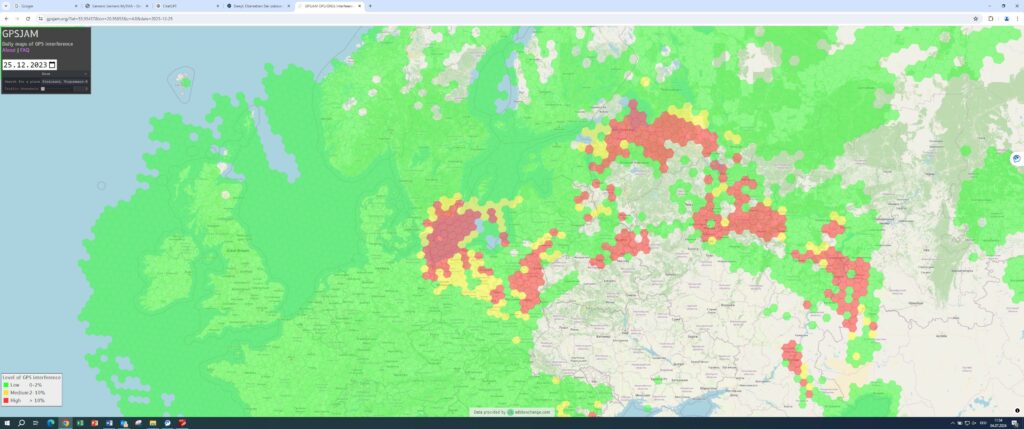GNSS Jamming and Spoofing: Navigating Challenges in the Baltic Sea
Global Navigation Satellite Systems (GNSS), including GPS, GLONASS, Galileo, and Beidou, are essential positioning systems for today’s maritime navigation. However, GNSS systems are vulnerable to jamming and spoofing, which can have serious consequences for maritime operations. The Baltic Sea is a vital area for international trade, with thousands of ships navigating its waters annually. The reliance on GNSS for accurate positioning and timing data makes this area susceptible to disruptions caused by jamming and spoofing, especially when we are considering automated vessels in the future.
GNSS jamming is the jamming or blocking of signals from various GNSS constellations. Due to the low transmission power of the satellites and their orbits at an altitude of approximately 20,000 kilometres above the earth’s surface, the GNSS signals can only be received with an extremely low field strength. Therefore, even interference signals with a low field strength can prevent reception of the signal on the earth surface.
GNSS spoofing is the transmission of interference signals that imitate the GNSS signals. The aim is to deceive GNSS receivers in such a way that incorrect position information is the result. Ideally, this would be incorrect position data that cannot be recognised by the receiving device without additional GNSS independent navigation.
Since the end of last year, a web portal (gpsjam.org) has reported a number of “low accuracy” GPS events, most likely caused by GPS jamming in the area of the Baltic Sea. The events are reported from aircraft flying across this area, based on their navigation system accuracy. Figure 1 is an example of a map (showing the situation on the 25.12.2023). Similar results have been reported on a number of other days in the past.
Consequences for Maritime Shipping
GNSS jamming and spoofing can seriously affect maritime shipping by causing:
• Navigation errors, which can lead to collisions or entering dangerous areas.
• Delays in operations, affecting delivery schedules and raising costs.
• Safety risks to crew and passengers due to inaccurate positioning.
In maritime shipping, satellite navigation is a primary sensor to determine position and timing. Other tools like radar and compasses can be used if GNSS fails. However, ships are becoming increasingly dependent on electronic positioning because many on-board systems, like AIS, track control systems and others, need accurate position and time data. As new technologies for navigation are developed to handle increased digitalisation and automation, it is important to consider and address these potential disruptions and intended misdirection in future alternative positioning systems. IALA is working on such alternative positioning solutions since many years. One of the most promising solutions is the R-Mode (Ranging Mode) which could be established using MF DGNSS radio beacons or the new VDES transmissions which use enhanced communication in the VHF band. Another approach is the use of Enhanced Radar Positioning System (ERPS) which is based on ranging to enhanced RACONS (radar beacons).
Alternative Positioning Methods (R-Mode)
To mitigate the risks associated with GNSS jamming and spoofing, alternative positioning methods are essential. These methods can provide redundancy and improve the resilience of maritime navigation systems.
A variety of technological solutions provide the potential to fulfil the backup requirements from IMO1 and IALA2 . Within the radio frequency domain existing maritime radio infrastructure can facilitate ranging information to a user receiver. One concept for providing a GNSS backup system is the Ranging Mode (R-Mode). This concept uses existing maritime radio infrastructure that is already widely used in the maritime sector. The systems that can be most usefully deployed are the medium frequency (MF) radio beacon system and the emerging VHF data exchange system (VDES).
EU Interreg Baltic Sea Area Project ORMOBASS (11/23 – 10/26)
The EU-funded ORMOBASS project aims to improve, test and enlarge the Baltic Sea R-Mode, from the Kiel Canal to the Gulf of Finland. Additionally, ORMOBASS is developing an interference monitoring system to check the reliability of satellite positioning and warn users of disruptions. The project also aims to support standardization by sharing valuable information with organizations like IALA, IMO, and ITU, ensuring system compatibility and aiding future development.
1.IMO A915 (22)
2.IALA R0129 (R-129) GNSS VULNERABILITY AND MITIGATION MEASURES

Authors: Michael Hoppe, Daniel Karbach, Michael Schütteler
Rapporteur: Paul Ridgway
